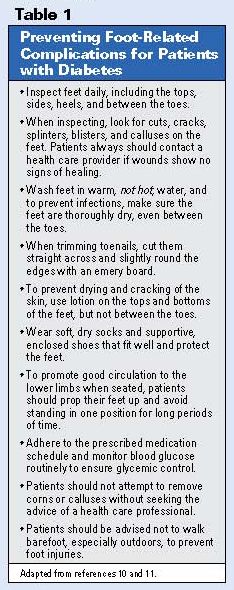Publication
Article
Pharmacy Times
2-Minute Consultation: Preventive Foot Care for Diabetes Patients
Author(s):
Ms. Terrie is a clinical pharmacy writer based in Haymarket, Virginia.
It is well understood that individuals with diabetes can develop various foot complications. Foot problems in patients with diabetes can be attributed to such factors as neuropathy, poor circulation, and decreased resistance to infection, as well as foot injuries or foot deformities.
Through early intervention and treat ment of foot problems, however, many diabetes patients may be able to prevent or deter serious complications, underscoring the need to educate patients about the importance of preventive foot care.
As many as 1 in every 4 patients with diabetes will develop a foot ulcer in their lifetime.1 The leading cause of foot ulcers is peripheral neuropathy. 1 Repeated pressure on the sole of the foot is another contributing factor. 1 If left untreated, the foot ulcer can become infected and cause further complications, which may eventually lead to a lowerlimb amputation.1
According to the American Diabetes Association (ADA), amputation and foot ulceration are the most common consequences of diabetic neuropathy and are considered to be the main causes of morbidity and disability in people with diabetes.2,3 In addition, the most prevalent cause of diabetesrelated hospitalizations is foot wounds.4,5 Statistics from the ADA reveal that >60% of nontraumatic lowerlimb amputations are among individuals with diabetes.6
In general, patients with diabetes also are considered to have a 30-fold higher risk over their lifetime of having a lowerextremity amputation, when compared with individuals without diabetes. Studies have shown that diabetes patients who smoke also have a higher risk of developing foot ulcers, because smoking may damage and constrict blood vessels.1,7 Other risk factors include poor blood glucose control, male sex, having diabetes for >10 years, and a history of ophthalmic, renal, and cardiovascular problems.8
Because neuropathy can cause a decrease in an individual’s ability to feel sensations, an irritation or injury to the foot can go undetected for a period of time if feet are not examined daily. In addition, having diabetes may increase an individual’s risk of developing other foot complications including 9,10:
• Infections such as athlete’s foot
• Foot ulcers
• Corns and calluses
• Dry, cracked skin
• Nail disorders such as fungal infections
• Hammertoes and bunions
• Brittle bones
• Charcot foot (a softening of the bones in the foot due to significant neuropathy)
Individuals with diabetes have at least a 10fold greater risk of being hospitalized for soft tissue and bone infections of the foot than individuals without diabetes.2 These alarming statistics underscore the need to identify those individuals at risk for foot complications, as well as the need to educate patients about the importance of appropriate foot care regimens to prevent and reduce complications. Table 1 offers suggestions for diabetes patients and their caregivers on prevention. The ADA’s 2009 standards guideline (Table 2) also outlines key recommendations for foot examinations, screening, and referral.



References
1. Singh N, Armstrong DG, Lipsky BA. Preventing foot ulcers in patients with diabetes. JAMA. 2005;293(2):217-228.
2. Lavery LA, Armstrong DG, Wunderlich RP, Mohler MJ, Wendel CS, Lipsky BA. Risk factors for foot infections in individuals with diabetes. Diabetes Care. 2006;29(6):1288-1293.
3. Abbate SL. Expanded ABCs of diabetes. Clinical Diabetes. 2003;21(3):128-133.
4. American Diabetes Association. Standards of medical care in diabetes—2009. Diabetes Care. 2009;32(Suppl 1):S13-S61.
5. Armstrong, D. and Lavery, L. Diabetic foot ulcers: prevention, diagnosis, and classification. Am Fam Physician.1998 Mar 15;57(6):1337-1338.
6. Complications of Diabetes in the United States. American Diabetes Association Web site. www.diabetes.org/diabetes-statistics/complications.jsp. Accessed September 23, 2009.
7. Smoking. American Diabetes Association Web site. www.diabetes.org/type-1-diabetes/smoking.jsp. Accessed September 23, 2009.
8. Diabetes foot care. Medline Plus Web site. www.nlm.nih.gov/medlineplus/ency/article/003937.htm. Accessed September 23, 2009.
9. Foot Complications. American Diabetes Association Web site. www.diabetes.org/type-1-diabetes/foot-complications.jsp. Accessed September 23, 2009.
10. Diabetic Complications and Amputation Prevention. The American College of Foot and Ankle Surgeons Web site. www.footphysicians.com/footankleinfo/diabetic-amputations.htm. Accessed September 23, 2009.
11. National Institute of Diabetes and Digestive and Kidney Disease. Diabetes-Related Amputations on the Rise; Daily Foot Care Can Help Reverse Trend [press release]. www2.niddk.nih.gov/News/SearchNews/11_01_2000.htm. Accessed September 23, 2009.







